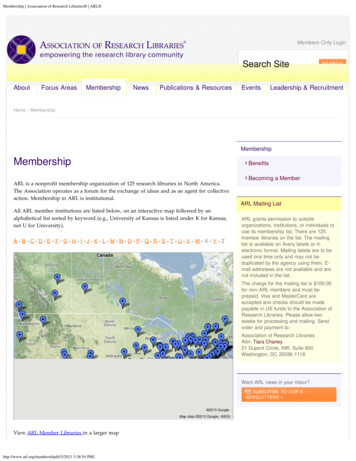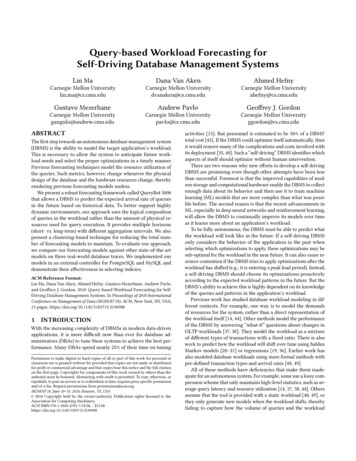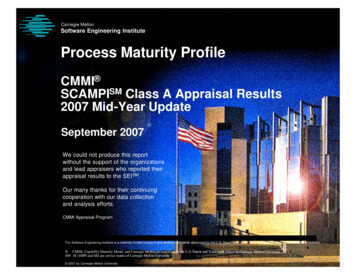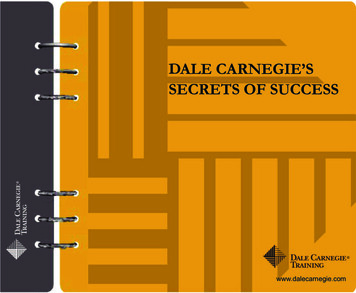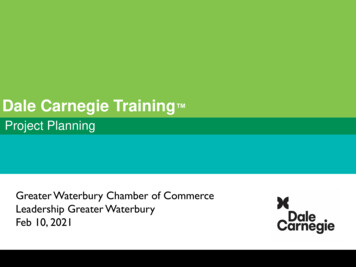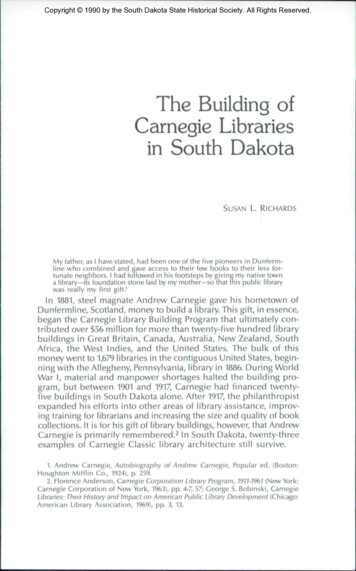
Transcription
Copyright 1990 by the South Dakota State Historical Society. All Rights Reserved.The Building ofCarnegie Librariesin South DakotaSUSAN L RICHARDSMy father, as I have stated, had been one of the five pioneers in Dunfermline who combined and gave access to their few books to their less fortunate neighbors. I had followed in his footsteps by giving my native towna library—its foundation stone laid by my mother—so that triis public librarywas really my first gift.'In 1881, steel magnate Andrew Carnegie gave his hometown ofDunfermline, Scotland, money to build a library. This gift, in essence,began the Carnegie Library Building Program that ultimately contributed over 56 million for more than twenty-five hundred librarybuildings in Great Britain, Canada, Australia, New Zealand, SouthAfrica, the West Indies, and the United States. The bulk of thismoney went to 1,679 libraries in the contiguous United States, beginning with the Allegheny, Pennsylvania, library in 1886. During WorldWar I, material and manpower shortages halted the building program, but between 1901 and 1917, Carnegie had financed twentyfive buildings in South Dakota alone. After 1917, the philanthropistexpanded his efforts into other areas of library assistance, improving training for librarians and increasing the size and quality of bookcollections. It is for his gift of library buildings, however, that AndrewCarnegie is primarily remembered. In South Dakota, twenty-threeexamples of Carnegie Classic library architecture still survive.1. Andrew Carnegie, Autobiography of Andrew Carnegie, Popular ed. (Boston:Houghton Mifflin Co., 1924), p. 259.2. Florence Anderson, Carnegie Corporation Library Program, 1911-1961 (New York:Carnegie Corporation of New York, 1963), pp. 4-7, 57; George S. Bobinski, CarnegieLibraries: Their History and Impact on American Public Library Development (Chicago:American Library Association, 1969), pp. 3, 13.
Copyright 1990 by the South Dakota State Historical Society. All Rights Reserved.2South Dakota HistoryIn his work Carnegie Libraries: Their History and Impact on American Public Library Development, George Bobinski emphasized therole Carnegie gifts played in furthering the development of the public library.3 Bobinski's interpretation certainly would have gainedAndrew Carnegie's favor. The steelmaker saw himseif as forming apartnership with communities to expand library service through hisgifts. He provided the building; each community funded books, supplies, and staff salaries. Socially and architecturally, the twenty-fiveSouth Dakota buildings made an imprint upon individual towns andthe state as a whole.The twenty-five communities in South Dakota to receive Carnegielibraries garnered a total of 254,000 (Table 1). Compared with eightstates of similar population. South Dakota ranks second in numberof libraries, behind Oregon (31), and third in total amount of moneyawarded, again behind Oregon ( 478,000) and Utah ( 255,470).5 In asix-state regional comparison (Iowa, Montana, Nebraska, North Dakota, South Dakota, and Wyoming), South Dakota ranked third inthe number of libraries, with Iowa (101 for 1,495,706) and Nebraska(69 for 706,288) far ahead. It was fourth in the amount of moneyreceived—Wyoming got 257,500 for sixteen buildings. Individualgrant size in South Dakota ranged from 5,000 for Dallas and LakeAndes to 30,000 for Sioux Falls. Sioux Falls was also the first community to secure money from Carnegie, receiving its award on 24January 1901, followed by Aberdeen on 14 March. Awards camesteadily to South Dakota towns until 3 May 1917, when the last awardwas made to Wessington Springs. The process a community went through to receive a Carnegielibrary changed over the program's duration. Throughout the sixteen years of South Dakota's participation, Carnegie's staff refinedthe application process, placed more controls on each community,and increasingly participated in the architectural design of the buildings. Carnegie's focus on iibrariesgrewout of his philosophy of giving. Hebelieved that a gift was beneficial only if the recipient workedto better his lot as a result. He therefore structured his library pro-3. Bobinski's book is the seminal work on the subject. For an opposite view withina state context, see David I. Macleod's, Carnegie Libraries in Wisconsin (Madison:State Historical Society of Wisconsin, 1968).4. Anderson, Carnegie Corporation Library Program, pp. 4-5.5. The eight states considered are Arizona, Montana, New Hampshire, New Mexico, North Dakota, Oregon, Utah, and Vermont, using 1900 population figures.6. Durand R. Miller, comp., Carnegie Grants for Library Buildings, 1890-1917{NewYork: Carnegie Corporation of New York, 1943), pp. 7, 21-40.
Copyright 1990 by the South Dakota State Historical Society. All Rights Reserved.Carnegie Libraries3TABLE 1SOUTH DAKOTA CARNEGIE LIBRARIES(in order of date awarded)LibrarySioux lionPierreWatertownCantonMilbankMadisonHot SpringsBrookingsHuronDell RapidsLake AndesDallasArmourRapid CityBrittonSissetonWagnerTyndallWessington SpringsDate Awarded24 January 190114 March 190110 January 190214 March 190214 March 190211 April 190220 February 190320 March 190313 April 19032 December 190411 April 190516 lanuary 19069 March 190713 December 190713 December 190720 November 190821 November 191128 April 191326 February 191411 March 19148 May 191411 June 19141 June 19153 December 19153 May 1917Amount ,00073001230073007,5005,0007,5007,000Sduaci Florence Anderson. Carnegie Corporation Library Prograrr], 7977-7967 (New York; Carnegie Corporationof New Vbrk, 1963), p. 58; Durand R. Miller, comp., Carnegie Grants for Library Buildings, 1890-1917 (New York:Carnegie Corporation of New York, 1943Ï, pp, 21-40.gram to require a community to provide books and ongoing libraryserviceJA community desiring a library building simply wrote a letter toCarnegie, requesting money. James Bertram, Carnegie's personalsecretary from 1894 to 1914 and the chief administrator of the program, answered the letter. Bertram sent the community a "Scheduleof Questions" to complete and return. The questionnaire asked applicants for the town's population, a description of present libraryconditions, the amounts collected and pledged in community taxes7. Andrew Carnegie, "Wealth," North American Review 148 (June 1889): 663-64, and"The Best Fields for Philanthropy," North American Review 149 (Dec. 1889): 688-89.
Copyright 1990 by the South Dakota State Historical Society. All Rights Reserved.4South Dakota Historyfor library support, an indication that a convenient site was available,and documentation of the amount of money in hand for a newbuilding. Officially, the community provided the site and levied taxesto support the library at ten percent of the Carnegie gift per year,with a minimum of one thousand dollars in annual support. Thismeant that Sioux Falls, which received a grant of thirty thousanddollars, had to provide at least three thousand dollars a year in taxsupport for library maintenance. The mayor or city council had topledge land and mill levy support; Carnegie did not accept documentation solely from the library board. Carnegie, through Bertram, considered certain factors when making awards. He refused state libraries and historical societies becausehe considered their resources to be sufficient without his aid. Communities with populations under one thousand were also not eligible because they lacked a viable tax base. The amount of moneyawarded depended upon population size, with two dollars per capitabeing the base figure and an additional allowance for projectedpopulation growth.3Some communities of adequate size failed to secure money. Othertowns that were awarded money could not take advantage of theirgrant. South Dakota had four such communities: Howard, Miller,Parkston, and Tripp. Howard was promised 7 00 but did not receiveit because of "architectural problems," most likely an inability toagree with Bertram on building design. Miller, which could also havereceived 7,500, wanted more funds, but had their request refused.Parkston ( 7 00) and Tripp ( 5,000) did not build with Carnegiemoney because they were unable to support a library at a rate often percent per year. Even Sioux Falls, which ultimately built a 30,000structure, hesitated in accepting its grant. In 1899, the city had beendeeded the All Souls Church building at Twelfth Street and DakotaAvenue by W. H. and Winona Axtell Lyon. The existing library hadjust completed remodeling and settled into these new quarterswhen news of the Carnegie gift arrived, presenting the city councilwith an awkward situation. The Lyons, however, released the cityfrom its obligations, took back the property, and cleared the wayfor Sioux Falls to build a new library. a Bobinski, Carnegie Libraries, pp. 38-40, 203-6. Carnegie was personally in chargeof deposition of funds until 1910. In 1911, he created the Carnegie Corporation ofNew York to distribute Ihe remainder of his assets.9. Ibid., pp. 45-46.10. Ibid., p. 135; R. E. Bragstad, S/oux fa//s/n Reíraspecí (Sioux Falls, S.Dak.: By theAuthor, 1967), pp. 61-62.
Copyright 1990 by the South Dakota State Historical Society. All Rights Reserved.Carnegie Libraries5In the early years, oncea community had sent an acceptance backto lames Bertram in New York, Carnegie's influence in the buildingprocess ended. He distributed the money in installments duringthe course of construction but exerted no pressure on the choosing of site, architect, or contractor. This period of relative localfreedom lasted until 1908 when reports reached New York that communities needed advice on library design. Beginning that year, Bertram requested that he approve all plans before constructionbegan—a tedious process that slowed building progress. To speedit up, in 1911 Bertram issued a pamphlet entitled Notes oti LibraryBildings, which employed simplified spelling. "This memorandum,"the pamphlet began, "is sent to anticipate frequent requests forsuch information, and should be taken as a guide, especially whenthe proposed architect has not had much library bilding experience.It should be noted that many of the bildings erected years ago, fromplans tacitly permitted at the time, would not be allowd now." Notes on Library Bildings attempted to set minimum standardsfor Carnegie libraries. It advised local leaders to choose a plan thatdid not waste valuable main-floor space in a large entrance or incloak rooms, toilets, and stairs. Bertram also discouraged fireplacesreal space wasters. "The bilding," he wrote, "should be devoted exclusively to: (main floor) housing of books and their issue for homeuse; comfortable accommodation for reading them by adults andchildren; (basement) lecture room; necessary accommodation forheating plant; also all conveniences for the library patrons andstaff." Notes went on to recommend a simple rectangular plan withone story and a raised basement. The pamphlet included four setsof sample space plans.The choice of an architect remained a purely local decisionthroughout the years of the program, and libraries enjoyed significant freedom in selecting a building's exterior design. Bertram explained that "no elevations ar given or suggestions made about theexteriors. These ar features in which the community and architectmay express their individuality, keeping to a plain, dignified struc-11. Bobinski, Carnegie Libraries, p. 4712. "Note on Public Library Bildings," in A Manual of the Public Benefactions ofAndrew Carnegie (Washington, D.C: Carnegie Endowment for International Peace,1919), p. 305. Bobinski cites the pamphlet as Notes on Library Bildings, and I havefollowed his usage. Carnegie was an advocate of the simplified spelling method, whichBertram adopted in his correspondence. All spelling peculiarities appear in theoriginal.13. Ibid., p. 305.
Copyright 1990 by the South Dakota State Historical Society. All Rights Reserved.6South Dakota HistoryThe Canton Carnegie library (above), funded in 1904, andthe Huron library (below), funded in 1907, were good examplesof the one-story, raised-basement, rectangular planfor library buildings. The two buildings show a remarkablesimilarity. The Huron library building is no longer extant.
Copyright 1990 by the South Dakota State Historical Society. All Rights Reserved.Carnegie Librariesture and not aiming at such exterior effects as may make impossible an effectiv and economical layout of the interior." The one-story,raised-basement, rectangular plan did place natural limits on whatan architect could do with the exterior. Furthermore, Bertram's comments seemed to affect architectural ornamentation—or lack thereof—on library buildings erected after 1911.Of the twenty-five Carnegie buildings erected in South Dakotabetween 1901 and 1917, thirteen were constructed prior to Bertram's1908 architectural review process, and fourteen were built beforehe published Notes on Library Bildings. When viewed as a group,all twenty-five are recognizable as small public libraries; they areone-story, usually rectangular buildings, with raised basements. Allare extant except those in Aberdeen and Huron. Twelve are still inuse as libraries, and the remaining eleven serve a variety of purposes.Those in Sisseton and Brookings are community centers. In Mitchell and Sioux Falls, they contain art museums, while those in Watertown and Milbank house county museums. A juvenile detentioncenter occupies the Pierre building, and the Boy Scouts and GirlScouts have their headquarters in the old Wagner library building.In Rapid City, Vermillion, and Yankton, business enterprises (adesign firm, law office, and restaurant, respectively) have made useof the space at various times.The architectural style of the twenty-five buildings is most oftenreferred to as Carnegie Classic, a reference to both the person(Andrew Carnegie) who made them possible and the style (Classical)they most often emulate. Many of the pre-1908 South Dakota librariesare fine examples of Carnegie Classic: a rectangular, T-shaped orL-shaped plan, stone or brick structures with rusticated stone foundations, and low-pitched, hipped roofs. The facade is symmetricalwith columns or pilasters supporting the pedimented entrance;these features give the buildings their Classical appearance.The interiors of these early buildings approximated the floor plansBertram distributed beginning in 1911. Steps, either outside or inside, often led the visitor to a central opening. The librarian's desk(today's circulation desk) occupied the center of the main floor, facing the entrance, with large rooms opening to either side. If T-shapedinstead of rectangular, the plan usually had bookstacks directlybehind the librarian's desk. State library organizations and nationalAmerican Library Association publications had distributed this simple, balanced plan, and it had enjoyed wide use prior to Bertram'spamphlet. In addition, the few architectural firms specializing in14. Ibid., p. 306.
Copyright 1990 by the South Dakota State Historical Society. All Rights Reserved.8South Dakota Historylibrary design also followed the form. Throughout the Midwest,Grant Miller and Normand Patton of Chicago designed over onehundred Carnegie libraries. In South Dakota, Joseph Schwartz ofSioux Falls designed the Sioux Falls, Vermillion, and Madisonlibraries. Here, as elsewhere, Bertram's suggested library floor plansmerely grew out of accepted library and architectural interiorgThe exterior style, although called Carnegie Classic, was not imposed by Andrew Carnegie, nor did he exert any discernible influence on its development. Bobinski asserted that Carnegielibraries ushered in the "beginning of modern library architecture,"but the style resulted more from several other factors at work during the early twentieth centuryj The Classical Revival style gainedpopularity in architecture after the Columbia Exposition of 1893.Public buildings of all types—banks, courthouses, schools—beganto exhibit Classical elements. The library, too, as a repository ofknowledge and one of a community's educational resources,displayed the prevailing school architecture of the time. In form andfunction, the Carnegie library resembled the brick or stone schoolbuilding. Architects and the community leaders employing themalso borrowed much exterior ornamentation from previously completed library buildings. Through the geographical distribution oftheir designs, the few architectural firms specializing in Carnegielibraries helped to spread the style that came to be known asCarnegie Classic. Communities also borrowed ideas from eachother. Lilly Borresen, the field librarian for the South Dakota LibraryCommission between 1913 and 1915, wrote to Leora Lewis, Rapid Citylibrarian, recommending a plan she had seen elsewhere. "I wish,"she said, "you might have one very much like the one in Two Harbors, Minn. 1 have the architect's plans, estimates, photographs ofexterior and interior. Altogether, it is the most satisfactory librarybuilding of its size and cost that I have seen anywhere/' 1S Charles C. Sou le. Library Rooms and Buildings (Boston: American Library Association Publishing Board, 1902); Small Libraries: A Collection of Plans Contributed bythe League of Library Commissions (Boston: American Library Association PublishingBoard, 1908); Grant C. Miller, "Library Buildings," Quarter/y of i/ie /oiva Library Commission 3 (Jan. 1903): 1-8; Paul Kruty, "Patton and Miller: Designers of CarnegieLibraries," Palimpsest 64 Ouly/Aug. 1983): 110; "Joseph Schwar(t)z, Sr.," ArchitectsNotebook, South Dakota State Historical Preservation Center, VermiUion, S.Dak.16. Bobinski, Carnegie Libraries, p. 192.17. Lilly M. E. Borresen to Leora Lewis, 2 Nov. 1913, Rapid City Public Library, RapidCity, S.Dak. Borresen was a native of Two Harbors, Minnesota, and that may explainher preference for the town's library building.
Copyright 1990 by the South Dakota State Historical Society. All Rights Reserved.Carnegie Libraries9líie Redfield Carnegie library, funded m 1902, displayed moreexpensive Classical elements, such as the dome and cupola.The spread of the Carnegie Classic style did not prevent individualcommunities from exhibiting originality, even some eccentricity, intheir choice of library buildings. Although such Classical featuresas domes or cupolas of varying sizes and styles were scorned bythe American Library Association because of construction expenseand an "undesirable effect upon interior arrangement," these formsadorned the Milbank, Mitchell, Pierre, Redfieid, and Vermillionbuildings.is Exterior building materials also varied. Sioux Falls, Mitchell, and Dell Rapids, for example, chose Sioux quartzite for theirlibraries; Pierre selected a smooth-cut multihued local stone; andHot Springs built with burnt orange sandstone.Three of South Dakota's "Carnegies" presented truly unique appearances when viewed in context with the other twenty-two. Watertown's library, funded by Carnegie in 1903, was the only one to usea rectangular plan with corner entrance. Built of tan brick, it hada crenelated roof line, giving it the appearance of a modest castle.The Milbank library (1905) employed an L-shaped plan, not unusualto Carnegie library architecture, but certainly unique among South18. Small Libraries, p. 11. An early photograph of the Rapid City Carnegie Libraryshows a cupola that is now gone.
Copyright 1990 by the South Dakota State Historical Society. All Rights Reserved.Early patrons (above) of f r '( n's reading roomof the Mitchell Carnegie library cluster around the frontdoor of the Sioux quartzite building (below).Dakota examples. Today, this library still bursts with architecturalornamentation: an intricate tile entrance floor, egg-and-dart patternin the capital of the pilasters, a domed central section, Palladianwindows, and a portico (facing the corner of the lot) reached oneither side by a flight of stairs. Hot Springs (1913), the plainest of
Copyright 1990 by the South Dakota State Historical Society. All Rights Reserved.The Carnegie library in Watertown. funded in 1903, displays acrenelated roof line, giving the appearance of a modest castle.these three, was boxy in appearance, with a rectangular plan andflat roof. Constructed of burnt orange sandstone in alternatelyrough- and smooth-cut courses, it had only a star pattern in the upper light of the sash windows for ornamentation. Correspondenceindicated Bertram significantly influenced the interior layout of thisbuilding. 9 Nonetheless, the citizens of Hot Springs obtained an19. Carnegie Library Correspondence, "Hot Springs, South Dakota," microfilm reelno. 14, Carnegie Corporation, New York, N.Y.Constructed of burnt orange sandstone, the Hot SpringsCarnegie library complemented other community buildings.
Copyright 1990 by the South Dakota State Historical Society. All Rights Reserved.Funded in 1905, the Milbank library, now the Grant CountyMuseum, was the only South Dakota Carnegie to employ the L-shapedplan. Its richly decorated exterior featured a portico roof andegg-and-dart pattern in the capitals of the columns (below).
Copyright 1990 by the South Dakota State Historical Society. All Rights Reserved.Carnegie Libraries13original exterior design that was architecturally sympathetic to othercommunity buildings.Watertown and Milbank library designs had predated Bertram'srequired architectural review, however. Beginning with Dell Rapidsin 1909, marked differences appeared in the style of South DakotaCarnegie libraries. Plainer, with little architectural detail and muchsmaller entrances, all buildings were rectangular in design; T-shapedor L-shaped plans no longer appeared. Although Bertram stressedthat decisions on exterior appearance rested with local officials, Bobinski asserted that Bertram was "deeply involved in architectural contro!." Such control yielded a definite lack of originality in the lasttwelve South Dakota structures. Only the Tyndall library, with itstile roof and bracketed eaves, broke out of the utilitarian mold.In fairness to Bertram, it must be noted that architectural styleitself underwent change during these years, and the dullness ofdesign was most likely not entirely his doing. The Classical modereceded in popularity as architects reacted to the influences of thePrairie School, the Art Nouveau style, and the Arts and Crafts movement. Architecture became simpler and more streamlined, with emphasis on efficient use of space. Some of the "stripped down"20. Bobinski, Carnegie Corporation, p. 63.The Tyndall Carnegie library, funded in 1915,broke out of the utilitarian mode of posi-1908 structuresvi/ith a red tile roof and handsome bracketed eaves.
Copyright 1990 by the South Dakota State Historical Society. All Rights Reserved.14South Dakota HistoryFunded in 1902, the Deadwood Carnegie librarycontinues to serve the enthusiastic Deadwood communitythat thronged to its formal opening in November 1905.appearance of the last twelve buildings undoubtedly resulted fromthese new movements in the architectural community. Finally, mostpost-1908 awards came in smaller dollar amounts. The pre-1908 buildings averaged 12,500 per award, while post-1908 buildings averaged 7,500 each. Rapid City (1914) received 12,500 for construction, whileBrookings and Hot Springs got 10,000 each. The other nine grantscame through at 7,500 or less (see Table 1). Fewer dollars meantfewer architectural details.Viewed individually or as a group. South Dakota's Carnegielibraries are an important chapter in the architectural heritage ofthe state. But what contribution did the libraries make to each community? Deadwood, founded in 1876 during the Black Hills goldrush, had an active library in temporary quarters for twenty yearsbefore obtaining its "Carnegie." The November 1905 opening of thenew library building—a grand event—attracted so many citizens that,"Doors, windows, nooks, aisles and every conceivable spot whereone could stand was taken by someone anxious to see and hearthe program."2i21. Deadwood Daily Pioneer, 8 Nov. 1905, quoted in "Deadwood Public Library,"n.d., p. 3, Deadwood Public Library, Deadwood, S.Dak.
Copyright 1990 by the South Dakota State Historical Society. All Rights Reserved.Camegie Libraries15For Dallas, the funding of the Carnegie library in 1913signified the town's viability as a community on the frontier.In April of 1913, the town of Dallas, South Dakota (population1,277), received a library grant of 5,000 from the Carnegie Corporation. The local paper captured the spirit of excitement and pride:"Alibrary is one ofthe greatest pleasures and conveniences offeredto the citizens. . . . Dallas is working for one end in view—namely,to build her city along the right lines and to build it so that shewill be looked upon as a home community."22 Dallas had only beena viable community since 1907 when the Chicago and NorthwesternRailway Company extended its branch line service from Gregory.23As a homestead registration point for the opening of Tripp andMellette counties, the town's population swelled. Town boosterssearched for respectability. The building of a library meant Dallashad met one more requirement of civilization. Along with the bank,the school, and the churches, a library signified that a town wasthere to stay.Architecture reflects society and its values. The arrival of a librarybuilding, one paid for by multimillionaire Andrew Carnegie, sym22. "Library Building for Dallas," Gregory County News, 8 May 1913.23. Dallas, South Dakota: The End ofthe Line (Dallas, S.Dak.: Dallas Historical Society,n.d.), p. 2.
Copyright 1990 by the South Dakota State Historical Society. All Rights Reserved.76South Dakota Historybolized that a community considered reading and the pursuit ofknowledge to be an important activity. All twenty-five South DakotaCarnegies reflected this emphasis through building sites locatedin the central, most active part of town—often in prime commercial space. Libraries at Brookings, Lake Andes, Madison, Pierre, andSisseton occupied lots adjacent to the county courthouse. Thosein Armour, Britton, Lake Andes, and Redfield fronted the main routethrough town. The remaining libraries bordered downtown businessdistricts, often only half a block away. By locating the new buildingin such a prominent place, city leaders emphasized the library'sworth."Finally, the architectural image conveyed by a Carnegie librarybecame the image of libraries everywhere. The shape and form ofthe Carnegie is synonymous with library—an irony, given the factthat Carnegie himself directly influenced the style minimally if atall. His money facilitated the spread of the style, but it was the purpose of the building (one that stayed constant until the beginningof the multimedia era in the 1960s), the importance of learning inthe communities, and the prevailing architectural forms of theperiod that dictated this style. Paul Goldberger, architecture criticfor the New York Times, summed up Carnegie Classic buildings:"They were earnest in design and planning and are well crafted.They were built in the belief that the library is a special place inthe community and should not look like another storefront.'' SouthDakota's Carnegie libraries do not look like storefronts. Instead, theyare unique community buildings.As a group, the twenty-three remaining South Dakota structurespresent a microcosm of the Carnegie Library Building Program. Constructed during its most active years, they varied in size, presenteda progression of designs, and reflected the influence of Bertram'sarchitectural review as well as the national popularity of various architectural styles, prevailing library architecture, and local community desires. Together, these influences dictated the final appearanceof each building. Once constructed, the Carnegie made both a socialand architectural comment. It said that the residents believed intheir town, in its permanence, and in the civilizing nature of a library.Architecturally, it represented a melding of function and design inthe decades before World War I and became a "classic" statementof main street America.24. John Brinckerhoff Jackson, Discovering the Vernacular Landscape (New Haven,Conn.; Yale University Press, 1984), p. 107. The library architectural guides of the timealso emphasized locating the building near the downtown. See Miller, "Library Buildings," p. 2.25. Quoted in Joseph Deitch, "Portrait: Paul Coldberger," Wilson Library Bulletm(Jan. 1987): 55.
Copyright 1990 by the South Dakota State Historical Society. All Rights Reserved.Copyright of South Dakota History is the property of South Dakota State Historical Society and its content maynot be copied or emailed to multiple sites or posted to a listserv without the copyright holder's express writtenpermission. However, users may print, download, or email articles for individual use.All illustrations in this issue are property of the South Dakota State Historical Society except for those on thefollowing pages: cover, from Rawlins Municipal Library, Pierre; pp. 12, 13, 14, 15, from Susan L. Richards,Brookings; pp. 21, 30, 39, 49, from Sylvia Abrahamson Aronson, Wannaska, Minn.; p. 33, from VerendryeMuseum, Fort Pierre, and Jim Dusen, Brockport, N.Y.
South Dakota buildings made an imprint upon individual towns and the state as a whole. The twenty-five communities in South Dakota to receive Carnegie libraries garnered a total of 254,000 (Table 1). Compared with eight states of similar population. South Dakota ranks second in number of libraries, behind Oregon (31), and third in total amount .


